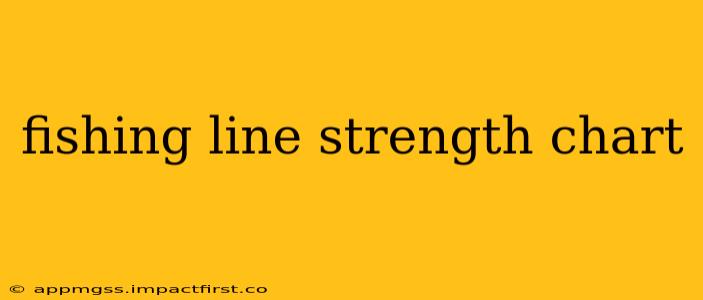Choosing the right fishing line is crucial for a successful fishing trip. Too light, and you risk snapping your line when you hook a big fish. Too heavy, and you might scare away smaller, more delicate fish. Understanding fishing line strength is key, and this comprehensive guide will help you navigate the complexities of choosing the appropriate line for your needs. We'll explore various line types, their strengths, and how to select the perfect line for different fishing situations.
What is Fishing Line Strength Measured In?
Fishing line strength is typically measured in pounds test (lb test). This indicates the maximum weight the line can hold before breaking. A 10lb test line, for example, theoretically can hold 10 pounds of weight. However, it's important to remember that this is under ideal laboratory conditions. Factors like knots, abrasion, and the type of line itself can significantly reduce the actual breaking strength.
Different Types of Fishing Line and Their Strengths
Several types of fishing line are available, each with varying strengths and properties:
- Monofilament: A classic choice known for its flexibility, knot strength, and affordability. Monofilament line is relatively forgiving, but it can be susceptible to abrasion and UV degradation over time. Strength varies greatly depending on the brand and diameter.
- Fluorocarbon: This line is virtually invisible underwater, making it ideal for clear water situations and finicky fish. It's also incredibly strong for its diameter, boasts superior abrasion resistance, and sinks more readily than monofilament. However, it's typically more expensive.
- Braided Line (Superline): Extremely strong for its diameter, braided line is a popular choice for saltwater fishing and applications requiring significant strength. It offers excellent sensitivity, allowing anglers to detect subtle bites. However, it can be more challenging to knot and is prone to wind knots.
How to Choose the Right Line Strength for Different Fishing Situations
The appropriate line strength depends heavily on several factors:
- Target Species: Larger fish require heavier line, while smaller fish can be targeted with lighter line. Research the average size of the fish you intend to catch.
- Fishing Location: Rocky areas or areas with heavy vegetation require a stronger line to withstand abrasion. Clear water may require a lighter, less visible line.
- Fishing Technique: Certain fishing techniques, like casting heavy lures, require a stronger line than others, such as bobber fishing for smaller fish.
What factors affect fishing line strength?
Several factors can impact the actual strength of your fishing line, even if it's rated for a certain pound test:
- Knots: Knots weaken the line significantly. Choose strong, reliable knots appropriate for your line type.
- Abrasion: Contact with rocks, vegetation, or even the fish's teeth can weaken the line over time.
- UV Degradation: Prolonged exposure to sunlight can weaken the line, especially monofilament.
- Line Age: Older lines are more prone to breaking, even if they haven't been subjected to significant stress.
What is the difference between line diameter and line strength?
While related, line diameter and line strength are not directly interchangeable. A thicker line generally has a higher pound test, but the relationship isn't always linear. Different line materials have different strengths for the same diameter. For example, fluorocarbon line is typically stronger than monofilament line of the same diameter.
How often should I change my fishing line?
The frequency of changing your fishing line depends on several factors, including how often you fish, the conditions you fish in, and the type of line you use. As a general rule, it's a good idea to inspect your line regularly for signs of wear and tear, such as nicks, abrasions, or discoloration. If you notice any damage, replace the line immediately. Otherwise, plan on replacing your line at least once or twice a year, or more frequently if you fish heavily.
Is there a universal fishing line strength chart?
No, there isn't a single universal fishing line strength chart. The strength of a fishing line depends on many factors including the manufacturer, the specific type of line, and even the batch. Always consult the specifications provided by the manufacturer for the exact line you are using.
This guide offers a foundational understanding of fishing line strength. Remember to always prioritize safety and responsible fishing practices. Choosing the correct line strength is a key element in maximizing your success and enjoyment on the water.
